Affiliate disclosure: This post may contain affiliate links. Please see our Privacy Policy.
Foraging is a year-round source of food and fun, no matter where you live. Our ancestors didn’t have the luxury of taking the winter off from food gathering, they just had to get more creative. There are hundreds of wild foods you can forage in winter, even in cold climates.
Here in Vermont, our frost-free growing season is only about 100 days long. Gardeners know how to plant frost-hardy vegetables to extend the season and die-hard foragers don’t take any months off. So what can you forage in when temperatures are 30 below outside?
It turns out…more than you’d think.
Foraging Nuts and Seeds in Winter
Seeds are nutrient-dense and tend to store well. Your main problem foraging seeds is competition. Did the squirrels and field mice beat you to your score, or is there still some to be had?
In a real emergency, finding a squirrel’s nut stash is a great way to get extra calories in the winter. Native peoples used to wait for squirrels to gather the best beech nuts and then raid the cache, which is a much more efficient way of gathering them than foraging yourself.
Unless you really need it, remember that the squirrel doesn’t have a grocery store, and so long as you do, it’s pretty cold-hearted to steal them.
Hop Hornbeam Seeds
The seeds inside of hophornbeam “hops” are small, but they’re plentiful. Each tiny nutlet is about the size of a sunflower seed and is encased in a papery husk.
It takes a bit of work to remove the husks, but the seeds can be toasted and eaten out of hand. The trees often hold the nuts on branches well into the winter, slowly dropping them in the wind and snow.
They’re always plentiful on the forest floor midwinter, and there’s a continuous crop. In late winter, hop hornbeam trees can also be tapped for syrup like maple trees.
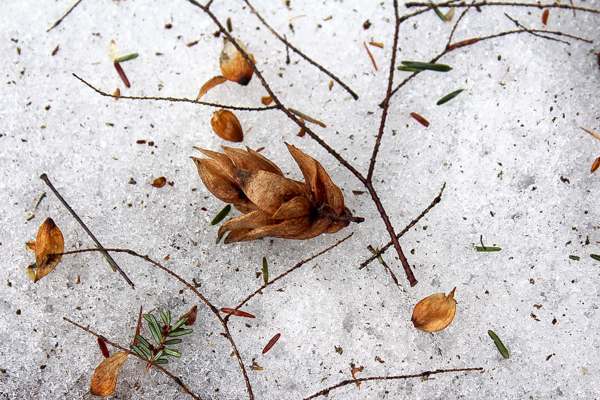
Table of Contents
- Foraging Nuts and Seeds in Winter
- Hop Hornbeam Seeds
- Black Walnuts
- Dock Seeds
- Acorns
- Beechnuts
- Pine Nuts
- Maple Seeds
- Goosefoot Seeds (wild quinoa)
- Foraging Fruit in Winter
- Crabapples
- Apples
- Rosehips
- Hawthorn Berries
- Chokeberries (Aronia Berries)
- Highbush Cranberries
- Teaberry
- Partridge Berries
- Grapes
- Foraging Greens in Winter
- Foraging Tree Leaves, Sap, and Bark in Winter
- Tree Bark
- Tree Sap
- Conifer Needles
- Foraging Roots in Winter
- Burdock Roots
- Foraging Mushrooms in Winter
- Foraging Moss, Lichen, and Seaweed in Winter
- Anything else?
Black Walnuts
Though they taste best if they’re removed from the husks quickly, black walnuts are often still abundant well into winter. They take considerable effort to crack, which means they’re not as popular with both foragers and squirrels.
Start by removing the pulpy outer husk, but be careful, it’s a powerful dye and it’ll stain anything it touches. After that, the nuts are inside very tough shells and can be cracked with a hammer or large rock and some elbow grease.
The extra time in the husk makes them a bit more bitter than normal, but they’re still worth eating.
In the fall, black walnuts drop from trees wrapped in a spongy green husk. That husk is used to make an iodine-rich black walnut tincture that can be used as a nutritional supplement (and antiseptic) if you’re away from sea-based iodine sources.
Once the green husk degrades, the nut shells are stained black by the dissolving husk (thus the name black walnuts). The nuts, still in their shells, will remain good to eat all winter long. The trick is beating the squirrels to them.

Dock Seeds
There are dock plants native to most places in the world, and they all produce tall shoots covered in seeds. The seed stalk is fibrous and remains upright even under heavy wet snow.
With several feet of snow on the ground, there’s still a good chance dock seed heads will be sticking up dotting the landscape.
Dock seeds are much like buckwheat and can be toasted and ground into flour. The seeds strip easily from the stalk, and you can gather enough to make a quart of flour in just a few minutes. Here are a few recipes for using dock seed flour.
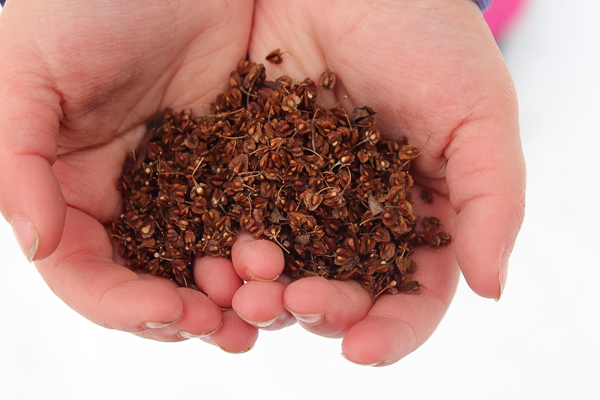
Acorns
In mast years, oak trees produce so many acorns that the squirrels can’t possibly get them all. A little digging under an oak tree and you’ll find enough to process into acorn flour. There are a number of ways to leach the tannins from acorns, but if you’re patient, the cold leach method allows you to do it without expending any extra fuel.
Acorns were a staple food in countries around the world, from Europe to Asia and the Middle east. If you’re not sure how to cook them, I’ve put together a list of more than 60 acorn recipes, both historical and modern.
Beechnuts
Your best chance to find beechnuts mid-winter is in a year with early snow. They’re particularly rich in fat and protein, much more so than acorns.
Squirrels put in extra hours gathering them until the snow blankets the ground. We’ve had snow in early October plenty of times, and in those years the beechnuts would still be hidden, waiting for a midwinter thaw.
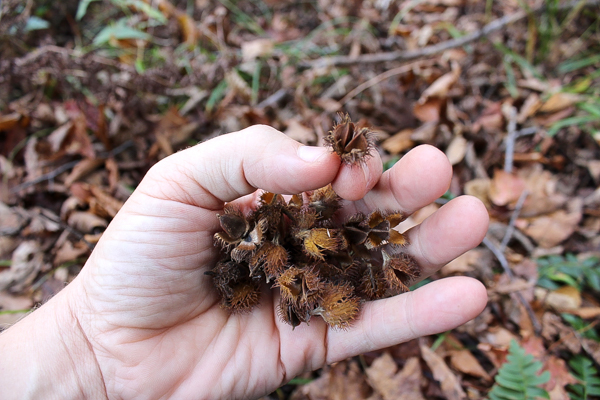
Pine Nuts
Often hanging on the trees until well into winter, pine cones can be a source of fat-rich pine nuts in the winter months. As with any nut, you’re competing with squirrels and rodents, and it takes a bit of work to extract the nuts. Check if you have any edible nut-producing pine species, as they vary by region.
In Vermont, there’s a non-native hardy Korean nut pine that is being planted by permaculture enthusiasts and it can be found in parks in our region.
Maple Seeds
Though they’re a bit tough and fibrous, maple seeds are edible. The trees wrap a pair of seeds in papery Y-shaped wings to help them catch the wind for better dispersal. Remove the papery husks, and you’ll find a few small seeds that make a good trail snack or can be roasted for better flavor.
They’re a bit astringent, and nothing to write home about, but they are edible and make a great winter survival food.
Goosefoot Seeds (wild quinoa)
Most foragers know about a tasty spring salad green called lambs quarter (or goosefoot) but few know that it’s actually a relative of quinoa.
That same tasty salad green will produce tiny black seeds in the fall, and those seeds will hang on rigid stalks throughout the winter. Just like dock seeds, you can find goosefoot seeds all winter long without even digging in the snow.
The real trick is processing them to separate them from the chaff, but here’s how to do it.

Foraging Fruit in Winter
Though you often think of fruits as highly perishable, cold winter temperatures actually help freeze them on the plant. If there is a good freeze/thaw cycle, some fruits will freeze dry and preserve well into spring.
Crabapples
I’ve gotta say, crabapples are one of the best-tasting things to eat while winter foraging. The winter cold actually helps bring out sweeter flavors, and they often hold on to the tree until the new buds break in spring.
Every March, wild turkeys descend on our land and fill the crabapple trees to gorge on crabapples that have made it through the winter. Sometimes I beat them to the punch, and harvest a basket or two full for a mid-winter crabapple jelly.
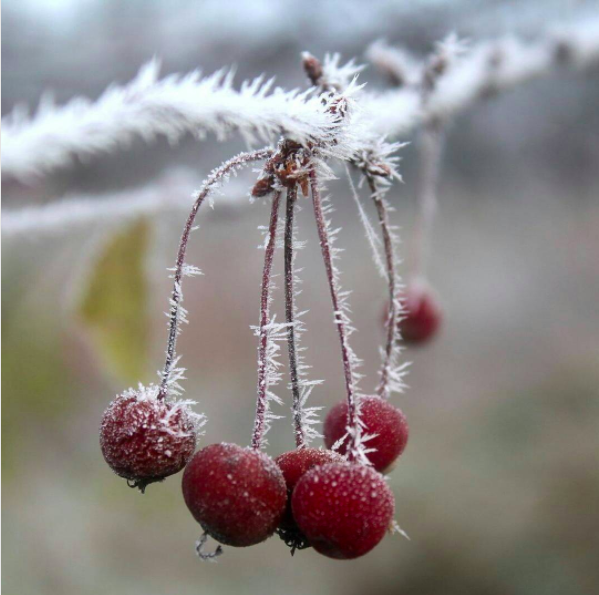
Apples
The apples that hang on trees into winter are called “ghost apples” and are often just shells of apples. But that’s not true for all apple varieties.
We put up cases of Newton Pippin Apples each fall and they’ll last a full year in our basement. Those we haven’t managed to harvest before a hard frost, we leave out on the tree. Years with constant cold, they’ll last to some extent into the spring, mostly feeding the deer as they slowly fall.
I harvested some in early March this year when we had our first patch of steady 40-degree weather. They were sweet, with a bit of effervescence.
After the first frost, many of the cells break and the surface yeasts are able to go to work fermenting the fruit into hard cider right on the branch. Humans developed the ability to metabolize alcohol so that they could get every last bit of nutrition out of spoiled fruit, and this ability helps us be able to enjoy slightly fermented fruit right off the tree midwinter.
Keep in mind that not all apple trees produce good storage fruit, and that weather conditions have to be just right to prevent the fruit from going too far south.
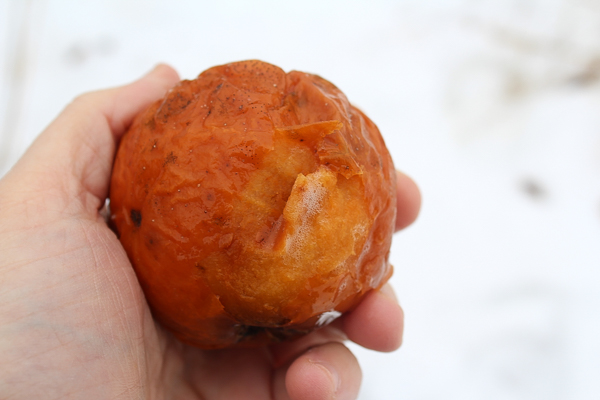
Rosehips
While truly “fresh” fruit is scarce in winter, rosehips are a great way to get much-needed vitamin C. They keep on the bushes all winter and into spring.
Pick them from wild rose bushes and boil them into a tea for a quick vitamin boost. The rose hips you find low on the plant, below the snow line, may still be soft enough for fresh eating. Fresh rose hips are not for the faint of heart, but give them a try if you’re feeling adventurous.
For the most part, we dry them for winter immune support teas. They also make a really good rose hip jam!
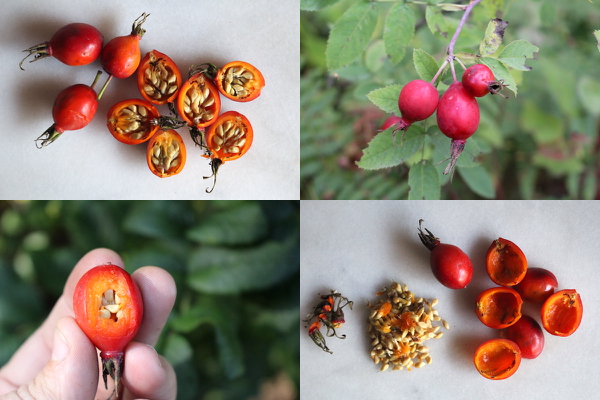
Hawthorn Berries
A bit like a cross between crabapples and rose hips, hawthorn berries are a tart and astringent tree fruit.
They hang on the tree all winter long, and they can be eaten like rose hips. Try making them into a cup of hawthorn mulled cider for wintertime warmth.
This year I cooked up hawthorn berry jelly and it’s delicious!
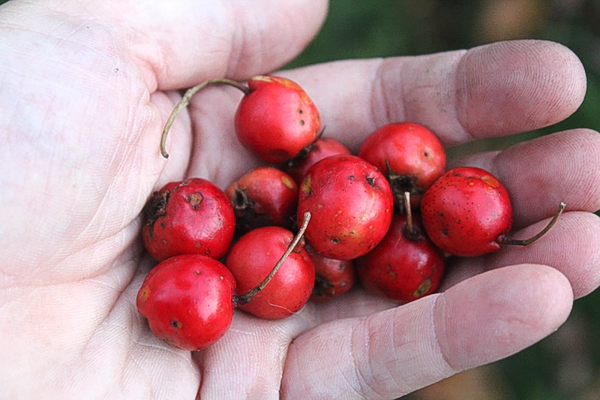
Chokeberries (Aronia Berries)
As the name implies, wild chokeberries are not the best-tasting fruits. They’re astringent, which makes them unpopular with birds, so they’ll hang on the branches well into winter. They do make a tasty jelly and can be used in meat sauces for added excitement and nutrition.
Chokeberries shouldn’t be confused with chokecherries, which rarely fully ripen on the bush before they’re harvested by wildlife.
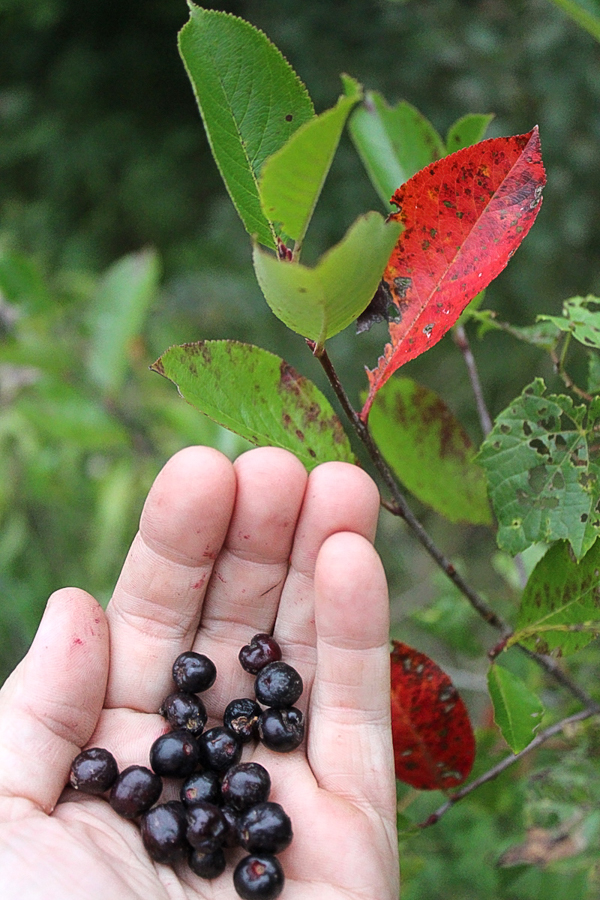
Juniper Berries
Evergreens don’t really give a darn about winter, and so it makes sense that their fruits wouldn’t be bothered either. Wild juniper berries are ripe for picking in wintertime.
They grow in zones 4 to 10, so there’s a good chance they may be available wherever you are.
Cranberries
Cranberries are low-growing ground cover plants that hold their fruit frozen beneath the snow until the spring thaw. I’ve eaten cranberries straight off the plant in March and they taste great.
You can find them during thaws, or by digging in the snow if you know where to look.
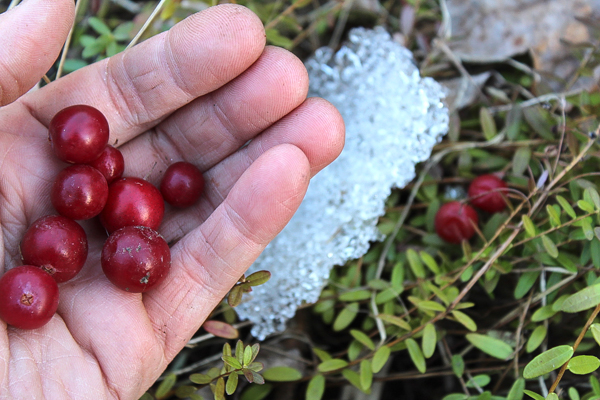
Highbush Cranberries
They’re not technically a cranberry, and if you cut one open you’ll find a big bright green seed that looks like a pepita. Nonetheless, highbush cranberries taste an awful lot like true cranberries.
They’re tart and acidic, but the quality of the fruit varies dramatically from plant to plant. Some are wonderful, and others will make you regret trying them.
Give them a tentative nibble, and if they’re tart, bright, and flavorful fill your sack.
Since they’re not particularly sweet, highbush cranberries often hang on the bushes through the winter. The birds will strip all the sweeter fruits before they go for these.
They may be still hanging there by the time it’s maple syrup season, and then you can cook them up with a bit of maple sap for a delicious cranberry maple syrup or jam. All wild foraged and winter harvested!

Teaberry
The tiny red fruits of the wintergreen plant, teaberries stay fresh underneath the snow cover until the spring thaw. They grow in shaded woodland areas and you can recognize the plants by their distinctive wintergreen scent.
Both the berries and the leaves are completely fine under the snow, and both are edible. Try making the berries into teaberry ice cream or the leaves into teaberry extract.
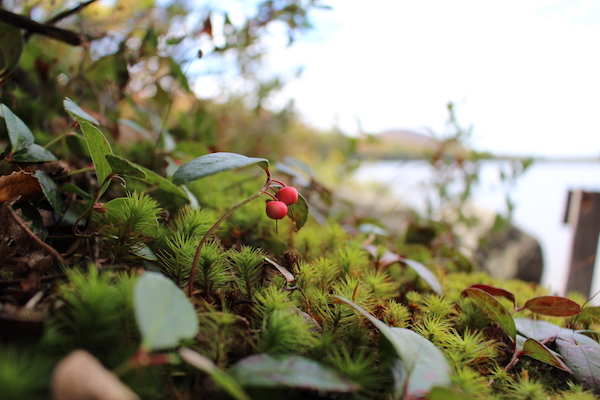
Partridge Berries
Similar to teaberries, partridge berries are a low-growing ground cover that stays fresh all winter long. They don’t have a wintergreen flavor or taste, and honestly, they don’t have much taste at all.
Just a tiny little packet of mild sweetness, which is pretty nice mid-January.
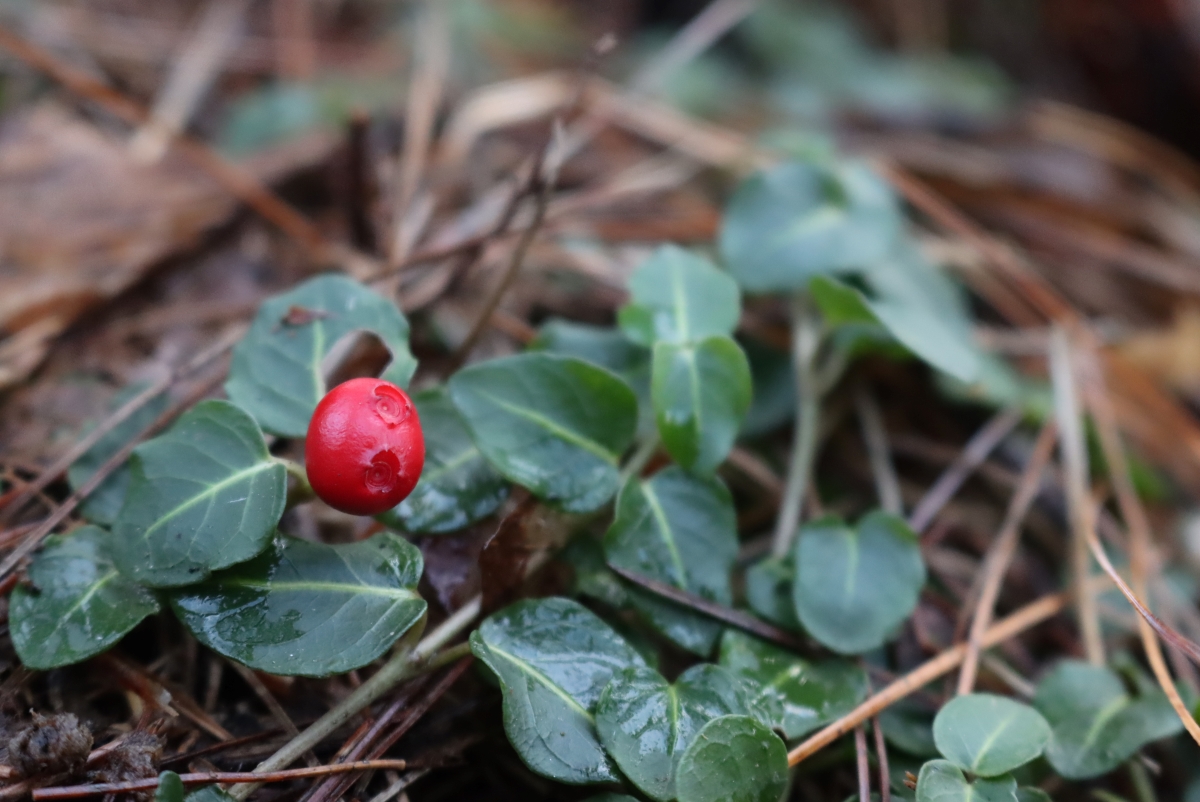
Grapes
Wild grapes turn into freeze-dried raisins in the winter months.
Grapevines that were hiding behind tree leaves are now exposed, and often enough they’re still covered with fruit. As the freeze-thaw cycle goes on throughout the winter, they slowly become freeze-dried raisins.
They’re not quite the same as commercial raisins because wild grapes aren’t as sweet, and they weren’t dried under controlled conditions.
Foraging Greens in Winter
Mid-winter seems like the worst possible time to try to forage greens, but even in zone 3 or 4, there are quite a few that keep on growing right through the coldest parts of the year.
Anytime the snow melts away enough, they take the opportunity to add a bit more bulk. Quick thaws are a great time to find winter greens.
Some greens will stay fresh under winter snow and then continue growing anytime the snow melts back a bit. Others just start very early in the spring, so early that it still technically winter.
Learn how to identify winter greens so you can harvest them during warm spells mid-winter. Good choices are:
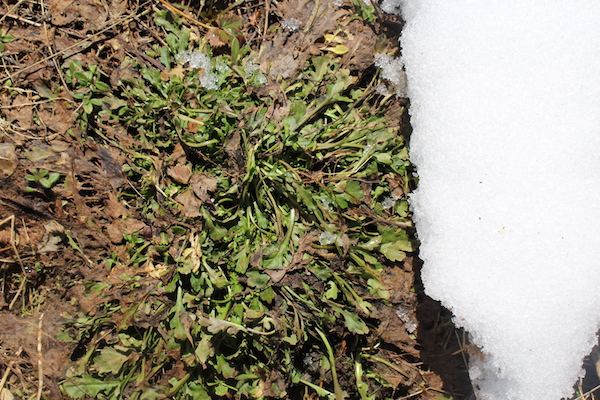
Foraging Tree Leaves, Sap, and Bark in Winter
I’ve already pretty well covered the fruits and nuts that come from trees that hang around all winter. The trees themselves still have more gifts to give.
Bark is surprisingly nutritious, and conifer needles are tasty as well.
Tree Bark
I know, it sounds pretty desperate to eat tree bark. Hundreds of years ago, believe it or not, it was a food for the rich in some Scandinavian cultures. The inner bark of birch trees can be made into a nutritious flour that tastes remarkably like buckwheat. The outer bark was cut to make food storage containers that actually helped prevent the food from spoiling.
Willow bark is well known for its aspirin-like medicinal uses. Willow catkins sprout in late winter or very early spring, and they’re both edible and a good source of vitamin C.
In the Rogers Herbal Manual, Herbalist Robert Rogers gives a recipe for tamarack bread:
“Scrape off the softwood and inner bark of tamarack, mix with water, and ferment into the dough to be mid with rye meal. Bury under the snow for a day. As fermentation begins, the dough can be cooked as a camp bread or as dumplings, the sweet wood pulp acts as a sugar for the yeast in the rye.”
Pine tree bark was used in multiple ways. The outer bark was used to flavor crackers and pine bark bread, and there’s some evidence that the tannins and other constituents helped the food keep and provided a medicinal benefit.
Pine inner bark was also made into flour, and the inner bark can be marinated and cooked into something that resembles bacon. I know, it’s tree bark, not real bacon, but the fact that you can make something that even approximates bacon from bark blows my mind.
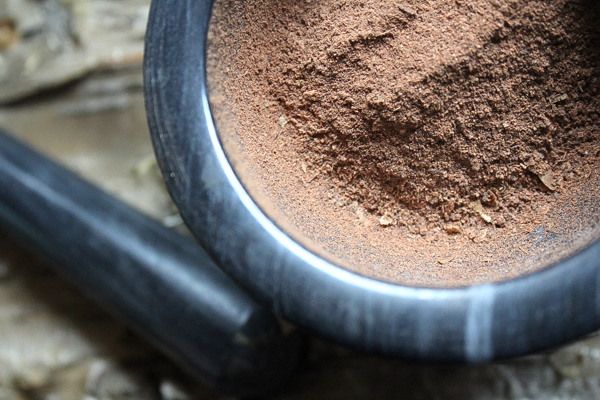
Tree Sap
Most people know that maples produce edible sap, but they’re not the only ones. Dozens of trees have edible sap that can be consumed as is, or boiled for syrup.
While it’s mostly limited to deciduous trees that lose their leaves, there are even a few conifers that get in on the action. According to A Boreal Herbal, which is a great resource for northern foragers, tamarack (larch) trees produce a sweet sap. “Many first nations people traditionally used larch sap as a natural sweetener, and the tasty, fresh spring shoots as an edible green. The inner bark was also ground into a powder and used as flour.”
Thus far, we’ve tapped quite a few as test cases including:
Conifer Needles
My husband gave me a really well-written historical fiction novel about the donner party a few years back for my birthday (he knows me well?), and I was struck by how they all seemed to be suffering from scurvy in a pine forest.
There are pine needles everywhere, how can you have scurvy? I guess if you don’t know that every part of a pine tree is edible and that you can cook them into a vitamin C rich pine needle tea, then you might well have scurvy in such a situation.
Conifer needles are good for more than just survival though. They can be made into a surprising range of tasty edibles, try any of these adventurous recipes:
- Douglas Fir Poached Pears & Frangipane Tart
- Frothy Douglas Fir Infused Eggnog
- Pine Needle Cookies
- Redwood Needle Shortbread Cookies
Foraging Roots in Winter
Foraging roots in winter is all about reading the landscape. You need to know what the dead brown top of a plant looks like, and then directly underneath you’ll find a root. Simple as that.
I suppose you also need to have a good working knowledge of which plants have edible roots. There are a surprising number of plants with starchy tap roots and even a few with medicinal roots that stand tall as they die to a dried-out brown color in the winter.
Burdock Roots
I’ll be honest, I can’t stand burdock roots. That said, many people love them, including my husband. They have an earthy flavor and a bit of bitterness.
I think they’re best used in a burdock tincture to fight inflammation or made into herbal cocktail bitters, but you can also cook them up and eat them.
Burdock stalks are edible and tasty in the fall when they’re green, and are by far the best-tasting part of burdock in my opinion. They won’t last into winter, unfortunately. They dry in winter and generally stay upright because the bur-covered seed balls want to stick to any passing deer (or human).
Those are a dead giveaway of a burdock root below.
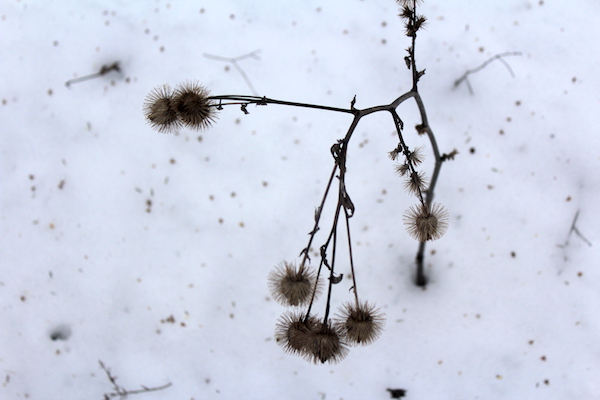
Other good choices for edible roots in winter include:
- Wild Parsnips
- Queen Anne’s Lace (wild carrot)
- Cattails
- Jerusalem Artichoke
- Chickory
- Thistle
- Elecampane (medicinal)
Foraging Mushrooms in Winter
Mushrooms seem like tender warm weather food, but many of them sprout and thrive regardless of the temperature. Most are medicinal, but a few edible mushrooms such as oysters also grow in winter.
Here are a few good options:
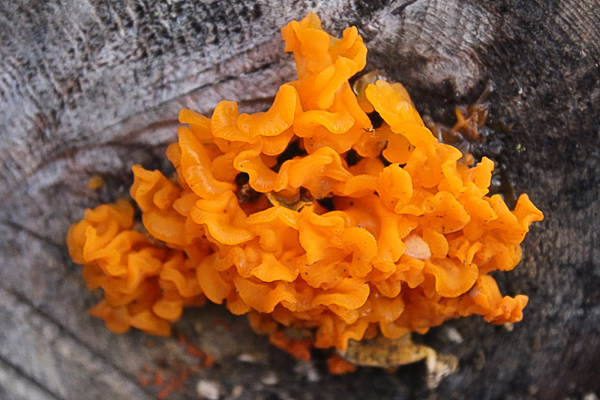
Foraging Moss, Lichen, and Seaweed in Winter
We’re not near the sea, unfortunately, so ocean foraging is out. And I’ve yet to forage lichens, but they’re definitely on my bucket list. I’ve heard mention of foragers hunting for all of these in the winter months.
- Usnea (medicinal)
- Reindeer Moss
- Kelp
- Dulse
Anything else?
What have I missed? I know that’s a lot of wild foods, but it’s barely scratching the surface. This, for the most part, is just a list of plants I have foraged in the winter months here in Vermont.
I’d love to hear what you’re finding out there where you live. Leave a note in the comments and let me know what I’ve missed.
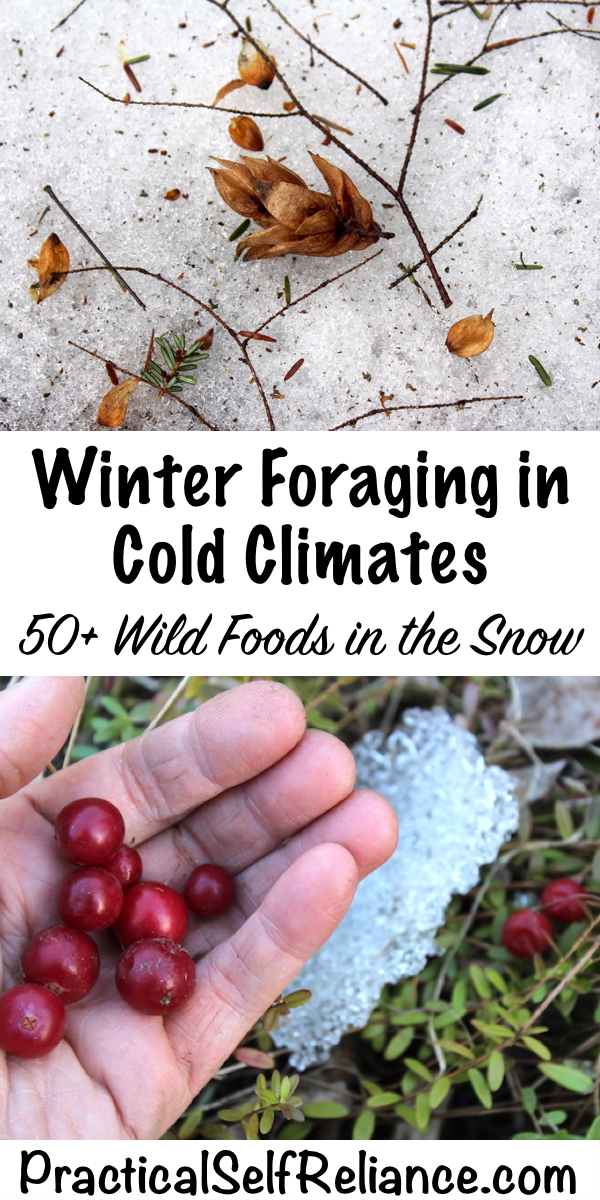
Still looking for more? Here are a few things to forage in the spring.














I live in Colorado, where several kinds of Locust; Black Locust (Robinia pseudoacacia), Honey Locust (Gleditsia triacanthos) and even a few populations of New Mexico Locust (Robinia neomexicanus), all of which keep their pods on the trees during most of winter. I have ground the small (1/8″) hard-shelled seeds of Black Locust for flour (though it has to be cooked well) and presume that the New Mexico Locust seeds can be used thus (though I’ll have to research). The much larger seeds of the Honey Locust (1/2″) extensively for the best coffee I have ever tasted from a foraged source. The semi-dried fruits of Prickly Pear Cacti (Opuntia phaeacantha) are also edible, and the sugars concentrate because of the cold. They are delicious after being blow-torched on a grill, washed in an ice bath, and scooped of their seeds (discard of the ends as well). these are the only edible plants I can think of in winter, that have not already been listed by practical self reliance.
Thank you for sharing those.
What a great, well researched, and informative list! I was especially interested to hear that the seeds of the Hop Hornbeam tree are edible, as we have them in abundance here in Midcoast Maine. One wild edible that I have been finding here where I live is the Japanese Bayberry (not to be confused with regular Bayberry). It is an oval-shaped red fruit that grows on a bush of thorny branch-like vines, and is tart like a cranberry. I’m pretty sure it is an invasive species here in Maine, as in some places in our woods it has completely taken over entire areas. But it is edible and I have even seen recipes where people have used in Risottas and other somewhat exotic dishes. I’m not sure how wide its range is across New England or the rest of the country, but it might be worth checking out for any aspiring foragers out there.
That’s great information. Thanks so much for sharing.
Wonderful and inspiring bit of knowledge! Thankyou once again 🙂
I have some things to add, if you would like:
Wood ear mushroom, amber jelly roll mushroom, Enoki mushroom
Also chaga, birch polypore, and artist conk can be used medicinally
You’re welcome. We’re so glad you enjoyed the post. Thanks for your suggestions.
I have hackberry trees and just learned the nuts can be roasted and ground for flour. Its definitely best to winter harvest. I’ve never done anything with them before, but plan to try making flour this January
That’s great. Let us know how it turns out.
This was awesome. You need to write a book. Have you?
We’re so glad that you enjoyed the post. No books yet but lots of people have asked.
This is a fantastic resource thank you!
I’m actually writing a children’s story that twill include a winter foraging trip, but I really only know warm weather foraging. I found this post while researching and I’m so excited because not only is this a fantastic resource, but I live in Vermont, too. You are completely describing my stomping grounds!
Thank you!!
Sounds like a wonderful book. So glad the post was helpful for you.
One way I have used the resinous sap that sometimes oozes from wind injured white pine limbs is as a fixative for my partial denture which covers roof of my mouth. When clear resin is smeared on the denture and put into place, it has a pleasant taste and is very slow to dissolve.
What a great tip. Thanks for sharing.
A great article, but somehow the comment about the “Permaculture” groups in Vermont planting a non native
tree, seems a little at odds with what the want to achieve.
Also as I am sure you are aware but maybe not all your followers are. When foraging don’t deplete a plants supply of seed or leaves or whatever. 10 – 20 % of what you are foraging from each plant is a good amount to take and leave the rest so both our plants and animals survive.
Bonjour! je suis au Québec et j’ ai cette plante que je trouve super!
Elle garde ses feuilles vertes tout l’ hiver…
Et c’ est une plante médicinale.
Chimaphila umbellata :Chimaphile à ombelles..
Merci! Pour votre article…
Wow, that’s amazing, I’d never heard of that one, but it looks like it is a hardy medicinal evergreen with really unique flowers! Thanks for that! https://en.wikipedia.org/wiki/Chimaphila_umbellata
Translation for everyone else:
“Hello! I am in Quebec and I have this plant that I think is great!
It keeps its leaves green all winter …
And it is a medicinal plant.
Chimaphila umbellata: Chimaphila umbellate.
Thank you! For your article …”
Hard to dig those roots when the ground is more like iron than soil.
Good basic info.
Anybody know if you can process and eat rose seeds?
Thanks for a great article! I run a FB wild foraging and medicinal plant group and I shared it on my group’s page.
Wonderful, thank you so much! I checked out your group, and the stuff you share there is really useful. I’ll put a link here in case anyone else is interested: Wild Edibles Of The Finger Lakes
I especially liked a link you shared recently that was a month by month foraging guide for New England, so I’ll put that here too if anyone else finds it helpful: https://joshfecteau.com/resources/wild-edibles-monthly-guide/
American mountain ash berries were an Ojibwe winter survival food
I loved your piece on winter foraging. Thank you so much. I know that I will not use or taste all of your offerings. Some do not grow in my little backyard. However, I have eaten purslane, chicory, dandelions, violet,roses and plantains. Cannot wait to try lilacs this Spring. Most important, I feel a measure of security knowing that if times get tough,that I can eat for free! Are water lily leaves edible? I have a huge potted cardamom plant that never produced seed pods. I break my back bringing it indoors for the winter. Makes a pretty houseplant. I love the smell of the leaves and wonder if I can use leaves to wrap and cook fish. I admire you so much. Thank you for all you share. Lena Romanoff